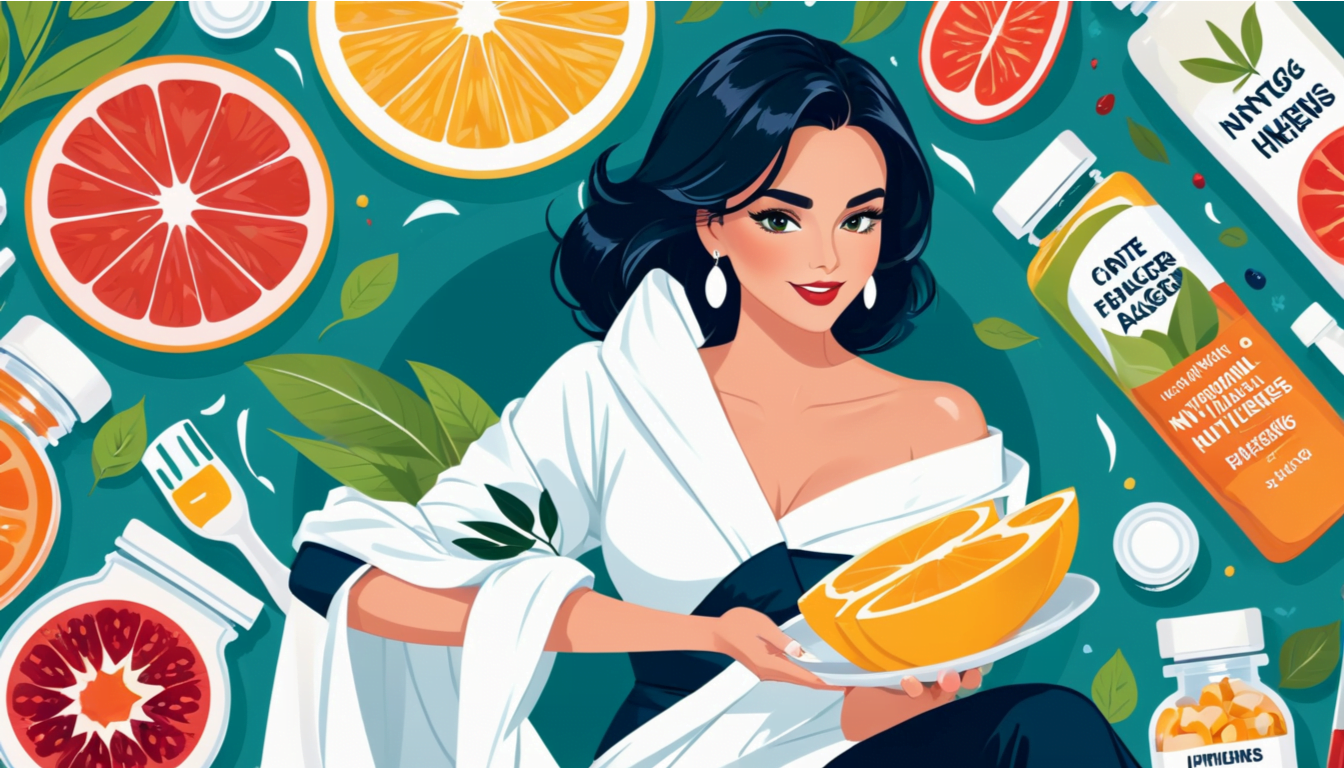Healthy eating is big business – with the market worth in excess of $945 billion a year, and growth still expected going forward. This leaves room for companies to expand their share and outpace rivals, so long as they adopt appropriate promotional tactics.
For marketers looking to boost brands associated with this sphere, social media is the obvious starting point. It’s just a case of understanding how social media marketers can leverage healthy eating trends for effective marketing. So let’s go over what you need to know and give you some ideas for what impactful campaigns should look like.
 Image Source: Microsoft Copilot
Image Source: Microsoft Copilot
Integrating AI for Personalized Healthy Eating Campaigns
Social media marketers now harness the power of artificial intelligence to craft personalized experiences for their audiences. This approach becomes especially relevant when promoting healthy eating trends. And with the spend on AI-enhanced ads topping $370 billion, it’s no longer a small-fry niche but a dominant trend.
Why focus on AI?
AI can analyze vast amounts of data, predicting consumer behavior with impressive accuracy. For example, by tracking user interactions and preferences, AI can recommend specific products or recipes adapted to individual tastes and dietary needs. Here are some other use cases:
- Tailored Recommendations: Imagine scrolling through your Instagram feed and seeing a suggested recipe that aligns perfectly with your dietary restrictions.
- Dynamic Content Creation: Marketers use AI-driven tools to generate content variations in real-time, ensuring relevance across different segments.
- Enhanced Customer Insights: With machine learning algorithms sifting through engagement metrics, businesses gain deeper insights into what health-conscious consumers truly value.
Real-World Implementation
Take the case of HelloFresh. They have been using AI for years now, not only to suggest meal kits but also to adjust portion sizes based on past order patterns – as well as for supply chain optimization and other behind-the-scenes operational shifts. So as well as offering low-calorie meals at your doorstep, this company can connect with customers in all sorts of contexts – using AI to enhance conversion rates as well as amping up retention once new users have been snared on social media.
Another fascinating development involves chatbots – a market that topped $5.1 billion in 2022 and is growing more than 23% annually. These aren’t just answering queries anymore; they’re providing nutritional advice based on users’ previous questions and habits logged over time.
Here are some actionable strategies for embracing AI in your own marketing efforts:
- Adopt Predictive Analytics Tools: Platforms like HubSpot offer integrations with predictive analytics tools that help forecast customer needs before they even realize them.
- Utilize Machine Learning Algorithms: These algorithms can parse social media data streams, identifying emerging health trends quickly so marketers stay ahead.
- Implement Smart Chatbots: Deploy chatbots capable of handling nuanced conversations about nutrition and suggesting suitable products or content in response.
Embracing these cutting-edge technologies allows social media marketers not just to reach potential customers but resonate deeply with their desire for healthier living options while delivering unprecedented personalization levels in every interaction.
Utilizing Influencers to Promote Nutritional Products
Leveraging influencers has proven effective in capturing the attention of health-conscious consumers. It’s a $24 billion industry, and 85% of marketers see it as an impactful way to get their products in front of audiences. This is because influencers offer a relatable and trusted voice that resonates well with target demos, making them perfect partners for promoting healthy eating trends.
Why influencers?
Influencers bring authenticity and trust to your brand’s message. Their followers often view their recommendations as genuine, especially when they align with the influencer’s personal lifestyle choices. Other perks include
- Expanded Reach: Collaborations can amplify your brand’s visibility across various demographics.
- Credibility Boost: When an influencer endorses your product, it lends credibility and trustworthiness.
- Engagement Rates: Influencer posts tend to receive higher engagement rates compared to standard branded content.
Strategic Partnerships
Take the collaboration between fitness guru Kayla Itsines and various nutrition brands. Her endorsements reach her more than 15 million followers, who look up to her for health advice, driving significant traffic toward these products.
Another example involves vegan chef Gaz Oakley teaming up with plant-based food companies – and even major chains like Wagamama. His innovative recipes showcase how versatile and tasty these products can be, encouraging his followers to try them out.
Here are some effective tactics to try yourself:
- Choose Authentic Voices: Partner with influencers whose lifestyles naturally incorporate healthy eating habits.
- Co-Creation of Content: Work alongside influencers to create engaging content such as recipe videos or wellness tips that highlight your product’s benefits without seeming forced.
- Utilize Multiple Platforms: Spread campaigns across platforms like Instagram Stories, TikTok challenges, and YouTube tutorials where different types of audiences engage actively.
Practical Steps
- Build relationships before business proposals to forge more authentic partnerships, resulting in content reflecting real enthusiasm rather than an unambiguous, half-hearted paid promotion.
- Create comprehensive guidelines for what you want influencers to do with their product promos while still allowing creative freedom; you want both parties to maintain authenticity in this context, and if it can’t be achieved, don’t move forward with the campaign.
- Track performance metrics diligently, measuring campaign effectiveness and adjusting strategies as needed to maximize overall ROI. Don’t be afraid to roll back decisions you made previously if the data shows that they weren’t on the right track.
In short, if you’re working on social media marketing and you need to push a product that’s aligned with healthy eating and lifestyle trends, you need to be approaching influencers to give campaigns a much-needed upward nudge. Just be sure that the partnerships you put together are well-chosen and keep all parties on a level pegging.
Leveraging Short-Form Videos to Showcase Easy Recipes
In the age of fast content consumption, short-form videos have become a powerful tool for social media marketers. Platforms like TikTok and Instagram Reels provide an ideal space to showcase easy-to-follow healthy recipes, capturing viewers’ attention within seconds. Instagram is particularly well suited to this – with 91% of its users consuming video content via an app that got its start as a purely photo-based platform, and the ideal length for clips here being 26 seconds if maximum engagement is to be achieved.
Why short-form videos?
Short-form videos offer immediate engagement. They are perfect for demonstrating quick meal preparations or sharing simple cooking hacks that make healthy eating accessible and appealing. Here are some other selling points for healthy eating trend-chasers:
- Instant Gratification: Viewers can quickly grasp the essence of a recipe in under 60 seconds.
- Visual Appeal: High-quality visuals entice users, making them more likely to try out new dishes.
- Shareability: Concise videos are easily shareable across platforms, expanding reach organically.
Creative Content Ideas
Think about what made Gordon Ramsay’s TikTok challenges so viral. He managed to pack his fiery personality into brief snippets while teaching viewers how to cook gourmet meals at home. This mix of entertainment and education proves highly effective.
Another example is fitness influencer Joe Wicks’ “Lean in 15” series on Instagram where he showcases nutritious meals prepared in just 15 minutes. His energetic presentation keeps audiences engaged while promoting practical, health-focused cooking solutions.
Innovative Strategies
- Recipe Demos: Create step-by-step video guides showing how to prepare delicious yet straightforward meals.
- Ingredient Spotlights: Highlight specific superfoods or seasonal produce with fun facts and simple recipes incorporating them.
- Interactive Q&A Sessions: Use features like Instagram Live or TikTok’s comment reply function for real-time interaction with followers interested in learning more about nutrition tips.
Engaging Through Visual Storytelling
Consider this: brands like Delish utilize dynamic editing techniques – speed ramps, close-ups on key steps – to make even mundane tasks visually captivating without overwhelming viewers information simultaneously introducing them subtly product offerings increasing likelihood purchases subsequently
Here’s another success story: Plant-based brand Oatly’s humorous yet informative reels dissect complex topics such as sustainable farming into digestible chunks inspiring viewers embrace plant-based lifestyles humor over lecturing leading increased brand affinity sales growth concurrently
Proven Tactics
- Experiment with different formats to identify what resonates best; be it time-lapses, mini-tutorials, or behind-the-scenes footage.
- Maintain a consistent posting schedule to keep your audience engaged and expecting regular content drops, rather than never knowing when you’ll be adding anything new, and falling out of touch as a result.
- Again, you need to track analytics diligently, refining your short-form content approach based on actual performance metrics rather than your gut feeling.
Put simply, short-form videos are the future of social media – and even platforms like X (formerly Twitter) which were once predominantly text-focused are moving over to this format, so you can’t afford to be left behind, whether you’re promoting healthy eating-associated products or anything else for that matter.
Building Community through Interactive Social Media Challenges
Interactive social media challenges have become a popular method for brands to engage with their audience. This is significant given that data suggests there’s a real divergence across platforms in terms of engagement rates – with TikTok leading the way with a 4.25% average, while Instagram sits in second place with 0.6%.
These challenges foster a sense of community, encouraging users to participate actively while promoting healthy eating habits. And while they’re hardly a new concept (Ice Bucket Challenge, anyone?) they still have a lot to offer.
Why interactive challenges?
Interactive challenges create excitement and engagement. They inspire users to share their own experiences, which not only boosts brand visibility but also builds a supportive community around healthful living. Other benefits include:
- User Participation: Encourages active involvement from followers.
- Community Building: Fosters connections among participants who share similar goals.
- Organic Reach: Participants sharing content amplifies the campaign’s reach organically.
Designing Effective Challenges
Consider the #SmoothieChallenge initiated by BlendJet. They invited users to create and share unique smoothie recipes using their portable blenders. The campaign saw thousands of creative entries, increasing product visibility and driving sales while highlighting easy ways to integrate nutritious options into daily routines. And most significantly, this is a hashtag that’s still generating traction today – showing that the right social media campaign can pay off in the long term.
Steps for Successful Implementation
- Clear Guidelines: Provide simple instructions on how participants can join the challenge.
- Incentivize Participation: Offer rewards or shoutouts for standout entries.
- Promote User Content: Share participant posts on your brand’s account, showcasing user-generated content (UGC) which helps build credibility and trust among new followers.
Enhancing Engagement through Gamification
Take Fitbit’s approach with its various fitness-related social media initiatives like step count competitions or content showcasing tips from fitness experts and even real users sharing their transformational stories.
By gamifying health goals, providing tangible rewards, and offering virtual celebrations, engagement rates increase significantly, and users form positive habits while also connecting with the brand more closely.
Practical Tactics
- Leverage platform-specific features; so for instance you might utilize Instagram Stories Polls or TikTok Duets to create dynamic, interactive experiences.
- Collaborate with industry influencers and thought leaders to increase participation in any challenges or UGC competitions you set up, earning wider recognition in the process.
- Analyze data collected in order to refine future campaigns – once more it all comes back to this last step if you truly want to see a positive change in social media campaign impact.
Most importantly, be thoughtful about how you organize any challenges on social media –not only as a means of staying in the good books of followers, but also in order to avoid the wrath of regulators. There are laws governing contests in this context, so keep this in mind to stay on the straight and narrow.
Final Thoughts
Ultimately it will take a combination of tactics – including AI for personalization, influencers for authenticity, short-form videos for engagement and challenges for community-building – to make a splash on social media. Even with the raft of attention earned by healthy eating trends, these tactics are necessary to stand out – and without them, you risk being eclipsed by better-known brands.
Once again we need to emphasize that even if you follow what we’ve discussed, your results will almost certainly be imperfect initially. That’s where using analysis of campaign performance, based on unambiguous data, will come into play – refining your content over time.




